8 Best Hiking Poles for Long Walks and Treks
Updated: Sep. 14, 2021
Hiking sticks are not for everyone, but they can be surprisingly helpful for many people. Here are some tips to help you find the best hiking poles or walking sticks for you.
Our editors and experts handpick every product we feature. We may earn a commission from your purchases.
The hiking pole is an underrated tool
Since prehistoric times, humans have used various walking sticks, from fallen branches and carved wooden staffs to the adjustable, ultralight trekking poles seen on trails today.
Walking sticks are not necessarily essential hiking gear, but they can be surprisingly helpful for many people in many situations. They provide enough benefits to outweigh the extra burden, which varies by material and features.
“Having hiking sticks, at least one of them if not two, are really good for getting some stability and balance, especially if you’re hopping on rocks,” says Kate Van Waes, executive director for the American Hiking Society (AHS).
“They’re good for balancing yourself if you’re going over tricky spots while carrying weight.”
Along with improved balance, walking sticks can reduce impact on your joints, too, potentially protecting you from knee pain and other common hiking maladies, according to the journals Medicine & Science in Sports & Exercise and Wilderness & Environmental Medicine.
They provide a boost when going uphill, as well as valuable support during descents, and they’re often useful for poking the ground to test the depth and consistency of mud, puddles, or snow.
Trekking poles can also reduce the perception of effort when hiking, helping it feel easier even if you’re burning more calories, per The Journal of Strength and Conditioning Research.
They can have some drawbacks, such as requiring additional energy from your upper body, occupying your hands, and adding more weight to the overall load you’re carrying.
Having ultralight hiking sticks can help with the weight and energy cost, though, and a foldable stick can also be stored more easily when you aren’t using it, thus freeing up your hands while you hike.
Here’s what to look for in a hiking stick. Plus, options that are worth the investment.

What to look for in a hiking pole or walking stick
The best walking stick(s) for you will depend partly on your personal preferences, as well as on the terrain and conditions where you plan to go for a walk.
Here are a few factors to consider when shopping for hiking sticks or trekking poles:
Material
The earliest walking sticks were likely all made from wood, and many still are today. That includes tree branches you find on the forest floor, of course, as well as canes, staffs, and other walking sticks carved from wood.
But walking sticks now come in other materials, too, so it’s important to weigh the pros and cons of each.
“Definitely, there are people who still prefer that traditional wood hiking staff, and really that comes down to personal preference,” says Wesley Trimble, communications and creative director for the AHS.
Wood is often stabler and more durable than other materials, he notes, but also heavier and less versatile.
It can work well for short walks and day hikes, but may become a nuisance on overnight backpacking trips, both due to its weight and its lack of folding or telescoping capabilities.
That’s why trekking poles now feature lighter material, usually either aluminum or carbon fiber.
Weight
Since wooden walking sticks tend to be heavier, people often use just one at a time for shorter hikes, Trimble explains, rather than in pairs like trekking poles.
Both aluminum and carbon-fiber walking sticks tend to weigh less than those made of wood, but carbon fiber is usually the lightest option. That makes it popular among many long-distance hikers, although it can be more expensive than aluminum.
Durability
The light weight of carbon-fiber walking sticks and trekking poles may come at the expense of durability, Trimble points out.
“Aluminum trekking poles are typically heavier and more durable, whereas carbon-fiber poles are lighter weight but can’t really bend, so they’re more likely to break.” Wood can be highly durable, but again, its weight and rigidity tend to rule it out for longer hikes.
Adjustability
Many aluminum or carbon-fiber walking sticks and trekking poles are adjustable, allowing hikers to lengthen or shorten them as needed. That can be helpful, Trimble notes, given the importance of using poles with the right length for your body.
“The length of trekking poles does matter,” he says. “The general rule is, if the pole is at your side, your elbow should be at about a 90-degree angle, with your forearm essentially parallel with the floor.”
Having an adjustable pole can not only provide some wiggle room, but it also gives you the option to adjust the length as you hike—extending the pole sometimes helps when going downhill, for example. Adjustable poles are easier to share, too, since they are customizable for different body types.
Despite these benefits, however, Trimble says he prefers single-length trekking poles to adjustable ones, both for their lighter weight as well as increased stability and sturdiness.
Foldability
Some people use walking sticks throughout their hike, while others save them for certain scenarios like descents, stashing them in their backpacks the rest of the time.
“For a wooden hiking staff, thinking about packability is also important,” Trimble says. Since it can’t be made smaller without breaking it, a wooden hiking stick may jut out from your backpack, potentially snagging on branches or other vegetation.
Many non-wooden walking sticks and trekking poles are collapsible in some way, often with either a telescoping or folding design. That can make a big difference for longer camping trips, when you may want to periodically pack them away and have free hands, but it could be unnecessary for a day hike.
Shock absorption
Some aluminum and carbon-fiber poles also have shock absorbers, helping soften the impact of repeatedly poking them into the terrain.
That can be valuable for long hikes with a heavy backpack, or when hiking on rocks and other hard surfaces, as the poles take some pressure off your hands and arms by absorbing a little more of the impact each time they touch the ground.
Baskets
Many trekking poles have “baskets” near the bottom, whose extra surface area helps prevent the poles from sinking too deeply into the ground, and also helps hikers push off the ground with each step.
The appropriate size of baskets depends on the terrain, with larger baskets often useful on snow or other wet ground. Smaller baskets can be lighter and less cumbersome, but they have drawbacks, too.
“I’ve found the trekking poles with really small baskets can get caught in boulders, so having a slightly bigger basket can help in some situations,” Trimble says.
Many companies make trekking poles with interchangeable baskets, allowing hikers to customize the size for each hike.
Cost
The cost of walking sticks and trekking poles varies widely, from less than $50 to more than $200. You may not need the most expensive models for a casual day hike, but while cheaper options are fine in some cases, you do tend to get what you pay for.
“It’s tempting to buy something cheaper, but I’ve found a lot of times going with quality and provable brands for outdoor gear, even if costs more up front, will last longer in the long run,” Trimble says.
(Here’s the other winter walking gear worth buying.)
The best hiking poles
With these factors in mind, here are some highly regarded walking sticks for hiking and trekking poles, including a few examples of various types.
Trekology Trek-Z Aluminim Trekking Poles
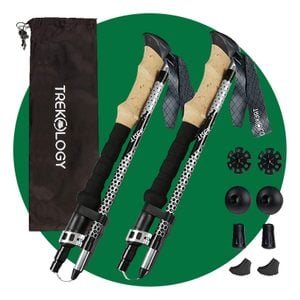
At less than $40, these folding and adjustable aluminum poles from Trekology offer a nice value for beginner and budget-conscious hikers. The poles consist of three sections, which can fold down to just 15 inches for portability, and use flip-lock technology for an adjustment range of about 7 inches.
They have moisture-wicking foam grips, and sturdy aluminum shafts for high durability. They’re on the heavy side, weighing more than 20 ounces per pair, but still a solid option for affordable, high-performance trekking poles.
Cascade Mountain Tech Carbon Trekking Poles
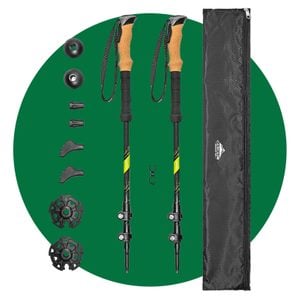
The lower weight of carbon-fiber trekking poles often comes at higher prices, but these Cascade Mountain poles offer the advantages of 100 percent carbon fiber for less than $50.
They’re adjustable and collapsible, with foam or cork grips, and a flip-lock telescoping design that can go from 54 inches fully extended to 26 inches when fully collapsed.
A pair of these poles weighs just under 1 pound (16 ounces) without tips, although as with carbon-fiber poles in general, they may be less durable than similarly priced aluminum options.
Black Diamond Alpine Carbon Cork Trekking Poles
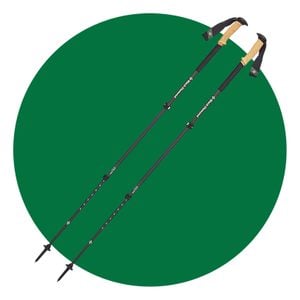
For more serious hiking in difficult terrain and variable conditions, these popular $180 poles from Black Diamond offer the light weight of fully carbon-fiber shafts (about 17 ounces per pair) with unusually high sturdiness and durability.
They also feature aluminum flip locks for adjustability rather than plastic, plus cork grips with foam extensions, although their price is a bit steep for many budgets.
Leki Micro Vario Carbon Trekking Poles
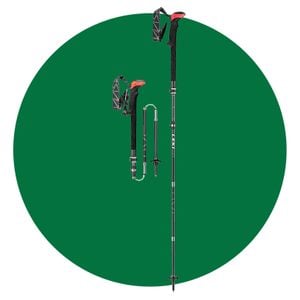
If you’re willing to spend $200 on trekking poles, these ultralight, compact, and adjustable Leki poles are probably worth consideration.
Made by German ski- and trekking-pole giant Leki, the 100 percent carbon-fiber Micro Vario poles are renowned for their light weight—about 1 pound per pair—as well as their high durability and performance, even in difficult conditions.
They’re highly compact, too, going from a fully extended 51 inches down to a collapsed length of just 15 inches.
High Stream Gear Aluminum Trekking Poles
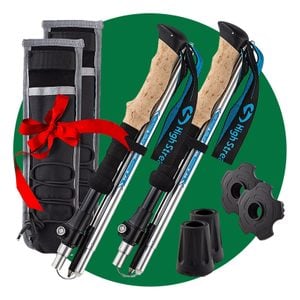
These aluminum High Stream Gear poles weigh more than 20 ounces per pair, but they combine the toughness of aluminum with high foldability.
They come in two sizes, measuring either 47 or 53 inches fully extended, and can collapse down to just 14.5 inches long at their most compact.
They’re relatively affordable at about $50 for a pair, and also come with carrying holsters for your belt.
TrailBuddy Aluminum Trekking Poles
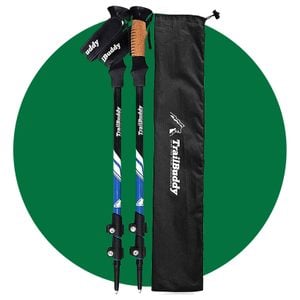
Another strong aluminum option, these TrailBuddy poles provide more durability than most carbon-fiber poles at a fraction of the price ($35). The trade-off is weight, as with other aluminum poles, although these still weigh roughly 20 ounces per pair.
They’re 54 inches long fully extended, and collapse down to 24.5 inches long for packing. They’re available in several colors, and come with accessories including mud baskets, snow baskets, rubber tips, and padded straps.
Leki Wanderfreund High Fives Walking Pole
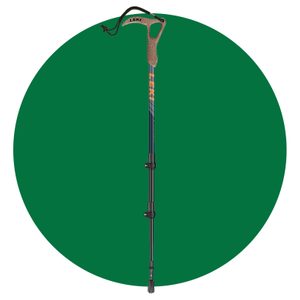
Some people prefer a single walking stick when possible, and that can work well in many situations. This solo Leki hiking staff weighs less than 10 ounces, yet also offers the sturdiness of aluminum, an adjustable shaft, and a cork handle for $70.
It may not be the best option for long backcountry treks, but it does offer versatility, potentially serving as a cane or walking stick for everyday use as well as a hiking stick for taking walks in the woods.
Leki donates a portion of the proceeds from this walking stick to the High Fives Foundation, a California-based nonprofit focused on preventing and providing support after life-altering injuries.
Brazos Wooden Hiking Stick
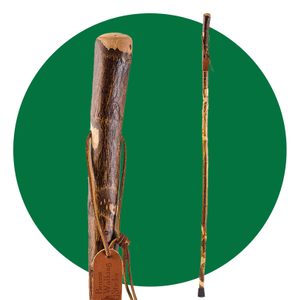
If you want a traditional wooden walking stick at a low weight and price, Brazos Walking Sticks might be able to help. The Texas company produces a range of wooden walking sticks with various designs and handle shapes, all made in the United States.
This model is available in several types of wood—including ash, oak, hawthorn, hickory, ironwood, and pine—as well as multiple lengths, from 41 up to 58 inches.
The weight and price vary by length and wood type, but the 55-inch hickory stick linked above weighs 1.35 pounds (21.6 ounces) and costs less than $40. That’s pretty light for a wooden walking stick, although it’s worth noting many pairs of aluminum or carbon-fiber trekking poles weigh less than this single walking stick.
Next, check out the best walking workout.

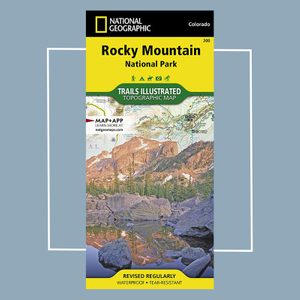

 Spectacular Summer Hikes" width="295" height="295" />
Spectacular Summer Hikes" width="295" height="295" />